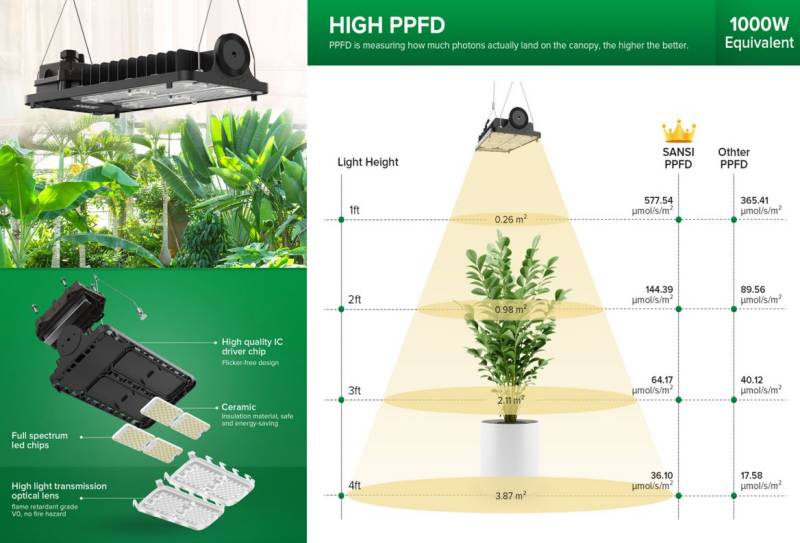When selecting the best LED grow light for your plants, it’s crucial to understand the terms used to describe light output. In the world of LED grow lights, two very important metrics are PPF (Photosynthetic Photon Flux) and PPFD (Photosynthetic Photon Flux Density). These measurements help determine how much light your plants receive, and they can guide you to make an informed purchase decision.
In this article, we will analyze the difference between PPF and PPFD, explain why they are important, and guide you on how to choose the right lighting solution based on these metrics.

What are PPF and PPFD?
Before diving into the differences, let’s first define these terms:
• PPF (Photosynthetic Photon Flux): This is the total number of photons in the 400-700 nm range (Photosynthetically Active Radiation, PAR) emitted by the light source per second. Its unit is μmol/s.
• PPFD (Photosynthetic Photon Flux Density): This is the number of photons that fall on a square meter of surface area per second. Its unit is μmol/s/m².
Both PPF and PPFD measure the amount of light available for photosynthesis, but they measure different aspects of light.
Difference Between PPF and PPFD
While both metrics measure the amount of light for plant growth, there is a key difference between them:
• PPF tells you how much light is emitted from the light source in total. This helps evaluate the overall output capacity of the light source.
• PPFD tells you how much of that emitted light actually reaches the plant surface. This metric is more practical because it reflects the effectiveness of the light reaching the plants, directly impacting plant growth.
For example, if you are planning to grow plants in a larger space, understanding the PPFD values at different locations (such as the plant canopy) will help ensure the plants receive adequate light, even if the light source has a high PPF value.
Why Are PPF and PPFD Important?
Both PPF and PPFD are crucial because they directly affect the efficiency of photosynthesis in plants:
• PPF is the measure of the overall intensity of the light source. The higher the PPF value, the more photons are emitted, meaning your plants can utilize more light for growth.
• PPFD is essential for understanding how much light the plants actually receive. If a light source has a high PPF but a low PPFD, plants won’t be able to effectively use the light for growth.

How to Choose an LED Grow Light Based on PPF and PPFD
When choosing an LED grow light, consider the PPF and PPFD values:
1. Consider the Coverage Area: PPFD is particularly useful for measuring the amount of light plants receive. If you are growing in a large area, ensure there is enough PPFD across the entire growing space.
2. Understand Your Plants’ Light Needs: Different plants have different light requirements. For example, leafy greens like lettuce may require a lower PPFD, while fruiting plants like tomatoes or peppers need higher PPFD levels for optimal growth.
3. Distance from the Light Source: The PPFD value decreases as the distance from the light source increases. Therefore, knowing how far your light source will be placed from the plants is crucial to ensure they receive enough light.
PPF and PPFD are two critical metrics when choosing LED grow lights. Understanding the difference between them will help you create the best lighting environment for your plants, ultimately improving their growth efficiency.
Ready to choose the right grow light for your plants? Learn more about our products to help you find the perfect LED grow light solution for your plant needs.